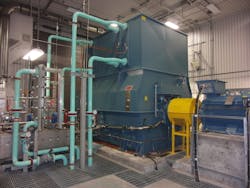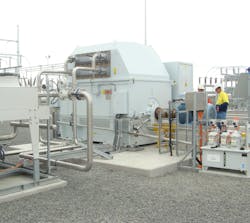As global power grids transition from centralized fossil-based generation to decentralized, renewable sources, system stability has become a critical challenge. The phasing out of synchronous generators has significantly reduced spinning inertia, fault-level support, and reactive power capabilities, all functions that are essential for grid reliability. In response, utilities and regulators are turning to advanced grid support technologies. Among these, synchronous condensers have emerged as a key solution.
Traditionally, power systems relied on the built-in spinning inertia of large synchronous generators. These rotating machines provided a vital kinetic energy reserve that absorbed disturbances, supported voltage, and contributed essential fault-level strength. As these units are retired and replaced with converter-based wind and solar plants, networks are becoming more susceptible to rapid fluctuations.
If left unaddressed, such vulnerabilities can lead to widespread operational disruptions and significant economic losses. Recent grid disturbances around the world have reinforced the need to maintain sufficient inertia and fault-level support as networks modernize and expand their reliance on renewable energy. The lesson is clear: stability must remain a priority in every transmission and distribution operator’s planning.
The case for synchronous condensers
Amid this increasingly fragile energy landscape, synchronous condensers (SCs) are experiencing a notable resurgence as a trusted solution for ensuring grid reliability. Utilities and grid operators are increasingly turning to SCs, which are fundamentally synchronous generators operating without a prime mover, to compensate for the loss of inertia, short-circuit capacity, and reactive power support.
Unlike purely inverter-based technologies, which can struggle to replicate the physical inertia of rotating machinery, synchronous condensers supply real rotating mass to deliver inertia, voltage regulation, short-circuit strength, and fault ride-through capability. A synchronous condenser’s primary function is to dynamically inject or absorb reactive power, thereby maintaining stable voltages across the grid. Its physical inertia supports frequency stability, helping grids withstand and recover from sudden disruptions.
This capability makes synchronous condensers a crucial asset for transmission system operators (TSOs) and large utilities, enabling them to integrate renewables seamlessly while maintaining system continuity. They also prevent widespread outages as these complex, multi-directional power flows become the new norm.
ABB’s role and innovations
Given the resurgence of synchronized condensers as a proven tool for maintaining grid reliability, ABB has focused on advancing this technology to meet the evolving needs of T&D professionals globally. The company’s latest whitepaper outlines innovative configurations, including modular designs, hybrid solutions that incorporate energy storage or power electronics, and specialized cooling solutions tailored for diverse climates. outlines innovative configurations, including modular designs, hybrid solutions that incorporate energy storage or power electronics, and specialized cooling solutions tailored for diverse climates.
These developments enable even remote or weak-grid regions to access dependable voltage and frequency support alongside improved operational flexibility. Scalable and hybrid configurations allow grid operators to adapt rapidly to changing network conditions and regulatory shifts, thereby minimizing system losses and reducing installation complexity.
Real-world impact
The practical value of synchronous condensers is best illustrated through real-world projects where they have enhanced grid stability and supported renewable integration under challenging conditions.
For example, at Darlington Point, home to one of Australia’s largest solar facilities, ABB supported compliance with stringent grid code requirements for inertia and fault current. The company installed two synchronous condensers that provided vital system inertia not only when the solar plant was generating, but also during nighttime operations. This approach strengthened the wider transmission network and set an important precedent for integrating large-scale renewable assets into reg ions with demanding technical standards.
Another example is ABB’s 2023 turnkey project for Statktaft, Europe’s largest renewable power generator, aimed at restoring lost system inertia and stabilizing the UK power grid. The project features two ABB high-inertia synchronous condenser systems installed at the Lister Drive Greener Grid Park in Liverpool, delivering a combined inertia of more than 900 megawatt seconds (MWs).
Enabling resilient power systems
The shift toward distributed energy resources, stricter reliability standards, and grid digitalization is driving strong demand for robust grid support solutions. ABB’s whitepaper highlights how regulators, from the EU to the US, are introducing policies that incentivize solutions like synchronous condensers, which can deliver critical system services. The growth of ancillary services markets now rewards operators for providing frequency regulation and voltage support, expanding the value proposition for utilities and independent system operators alike.
ABB’s modular and hybrid solutions address both new build requirements and strategic retrofits, providing support across a spectrum of applications, from weak, remote networks to major grid-connected renewable hubs.
The road ahead
As the global energy landscape grows more decentralized and digital, grid resilience becomes increasingly vital. ABB remains committed to delivering the expertise, technology, and partnerships that utilities and developers need to navigate this transformation successfully.
Synchronous condensers are proving to be not only fundamental to modern grid stability but also a cost-effective solution for ensuring resilience as energy systems digitize and decentralize. The result is fewer blackouts, optimized renewable energy integration, and infrastructure ready to meet the challenges of a future defined by climate goals, evolving policies, and new market demands.
Sponsored by:



